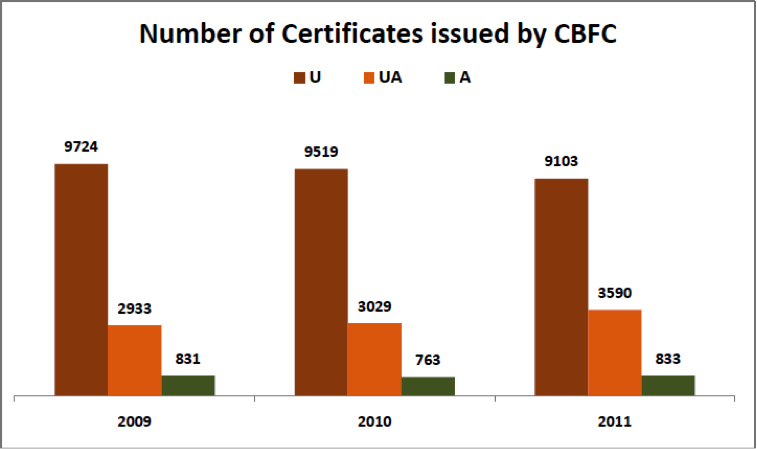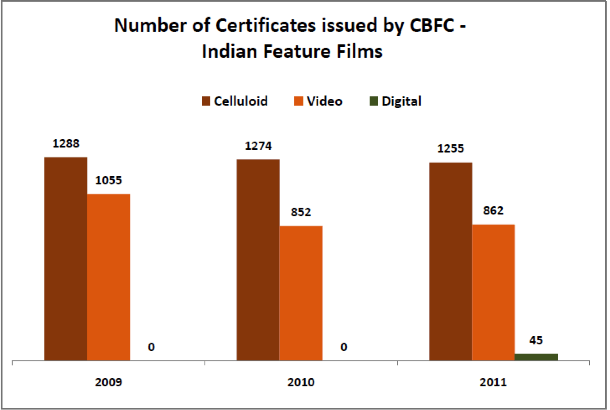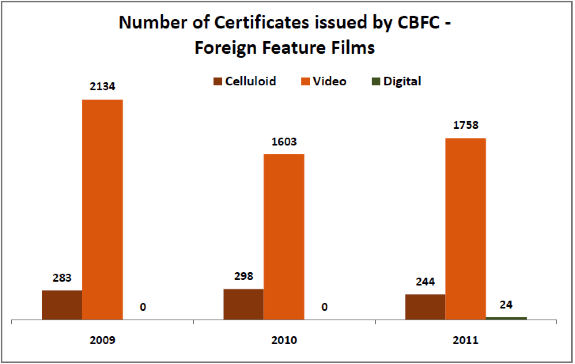[orc]The issue of Film Certification has been discussed time & again in the context of the role of the Censor Board. But how does the Censor Board certify a film? What is the process followed? Who certifies a film and how?
Indian Film Industry is the largest, making over 1250 feature films every year and a much larger number of short films every year. There has always been a lot of discussion over film certification; more so lately after the censor board issued a list of banned swear words. This drew a lot of ire from the filmmakers that such actions are against the freedom & creative liberty. In this multi-part series on CBFC, we start with taking a look at what CBFC is and how the films are certified.
Why is Film Certification Necessary?
The Supreme Court in a judgment in 1989 said, ‘Film censorship becomes necessary because a film motivates thought and action and assures a high degree of attention and retention as compared to the printed word. The combination of act and speech, sight and sound in semi darkness of the theatre with elimination of all distracting ideas will have a strong impact on the minds of the viewers and can affect emotions. Therefore, it has as much potential for evil as it has for good and has an equal potential to instill or cultivate violent or good behaviour. It cannot be equated with other modes of communication. Censorship by prior restraint is, therefore, not only desirable but also necessary.’
What is Central Board of Film Certification (CBFC) or the Censor Board?
Central Board of Film Certification (CBFC) or more commonly known as the Censor Board is a statutory body under Ministry of Information & Broadcasting, regulating the public exhibition of films. The board, set up under the Cinematograph Act, 1952 functions with its headquarters at Mumbai. The CBFC has nine regional offices, one each at Mumbai, Kolkata, Chennai, Bangalore, Thiruvananthapuram, Hyderabad, New Delhi, Cuttack & Guwahati. Currently headed by Pahlaj Nihlani, the members of the panel are appointed by the Central Government for a period of 2 years by drawing people from different walks of life.
At present, films are certified under 4 categories: U, UA, A& S.
| Category | Description |
|---|---|
| U | Films considered suitable for unrestricted public exhibition |
| UA | Films which contain portions considered unsuitable for children below the age of twelve, but otherwise suitable for unrestricted public exhibition |
| A | Films considered suitable for exhibition restricted to adults only |
| S | Films restricted for exhibition to specialized audience such as doctors etc. |
Number of Films Certified
According to the official figures from CBFC, a total of 40,325 certificates were issued by CBFC between 2009 & 2011. (Data is only available up to 2011 on the CBFC website)
The Process for Certification of Films
The Cinematograph Rules explicitly state the process to be followed by a producer to get his film or video film certified, including the materials to be submitted and the fees to be paid.
- Every application to certify a film for public exhibition will have to be made in writing and submitted to the regional officer of the concerned regional center in a prescribed form.
- On receipt of all the film material, requisite fees and written matter required under the rules, the regional officer will form an Examining Committee to view the film. The Examining Committee, in the case of a short film, will consist of an officer of the CBFC and one advisory panel member either of whom shall be a woman. In the case of a feature film, two of the four persons shall be women.
- After the film has been previewed, the CBFC has to ensure that each member gives a report in writing about deletions, modifications and the certificate the film should be given. The report is then submitted to the Chairperson who will ask the regional officer to initiate further procedures.
- However, the Chairperson can refer the film to Revising Committee on his own or on the request of the applicant. The appeal to the Revising Committee can be made within 14 days of the board’s decision. The Revising Committee will consist of Chairperson, in his absence, a board member and members drawn either from the CBFC or the advisory panel. None of the members who were on the Examining Committee can be on the Revising Committee.
- The Revising Committee will view the same film print shown to the Examining Committee without any changes, and each member will be required to record his verdict before leaving the theatre. The Chairperson may direct another Revising Committee to watch the film if he/she is not in agreement with the majority view.
- After the applicant is apprised of the decision of the Board, he/she will need to delete any portions (if so directed) and submit them to the regional officer, along with a copy of the film as certified. Before the board passes any order affecting the applicant of a film, the applicant is given an opportunity to represent his views in the matter before the EC/RC.
- If the applicant is aggrieved by the order of the board, an appeal can be made to the Film Certification Appellate Tribunal headed by a retired judge as a Chairperson. The appeal can be made within 30 days of the board’s decision. The FCAT may hear both the applicant and the CBFC before coming to its judgment.
Time limits for the Certification Process:
Rule 41 of the Cinematograph rules prescribe the following time limits for the certification process:
| Process | Time Limit |
|---|---|
| Scrutiny of Application | 7 days |
| Formation of Examination Committee (EC) | 15 days |
| Forwarding the EC report to Chairman | 10 days |
| Communication of the order to the applicant | 3 days |
| Surrender of cuts by the producer | 14 days |
| Examination of cuts | 14 days |
| Issue of Certificate | 5 days |
| Total Time Limit | 68 days |
The following documents show the entire process step by step for the film Munna Pandey Berozgaar. These documents have been obtained under the RTI act by Media Watch India, a non-profit working for accountability in the Media.
Sample Form 1A – Munna Pande Berozgaar:
Sample Examining Officers Response – Munna Pandey Berozgaar:
Voluntary and Recommended Cuts List – Munna Pandey Berozgaar:
Cuts Verification by Examining Committee – Munna Pandey Berozgaar:
Sample Examining Officers Response – Munna Pandey Berozgaar:
Sample Final Certificate – Munna Pandey Berozgaar
The complete document for the Certification of the film, Munna Pandey Berozgaar can be found here.
The Guiding Principles in Certifying Films
The Cinematograph Act lays down that a film shall not be certified if any part of it is against the interest of the sovereignty and integrity of India, the security of the State, friendly relations with foreign States, public order, decency or involves defamation or contempt of court or is likely to incite commission of any offence.
The Central Government has issued a detailed list of guidelines, which include some of the following:
- The medium of film remains responsible and sensitive to the values and standards of society;
- Artistic expression and creative freedom are not unduly curbed;
- Certification is responsible to social changes;
- The medium of film provides clean and healthy entertainment; and
- As far as possible, the film is of aesthetic value and cinematically of a good standard.
- Anti social activities such as violence are not glorified or justified
- Showing abuse or ridicule of physically and mentally handicapped persons
- Scenes involving sexual violence against women like attempt to rape, rape or any form of molestation or scenes of a similar nature are avoided, and if any such incidence is germane to the theme, they shall be reduced to the minimum and no details are shown.
- Visuals or words which promote communal, obscurantist, anti-scientific and anti-national attitude are not presented






3 Comments
if you cans censor a film for violence/nudity then why do you not censor a film for bad language.
Pingback: Is Censorship a Necessary Evil? | IIPRD Blog - Intellectual Property Discussions
Thanks For The Information, Just Wanted To Know,
Do Hollywood Movies Also Need Film Certification For Release In India?